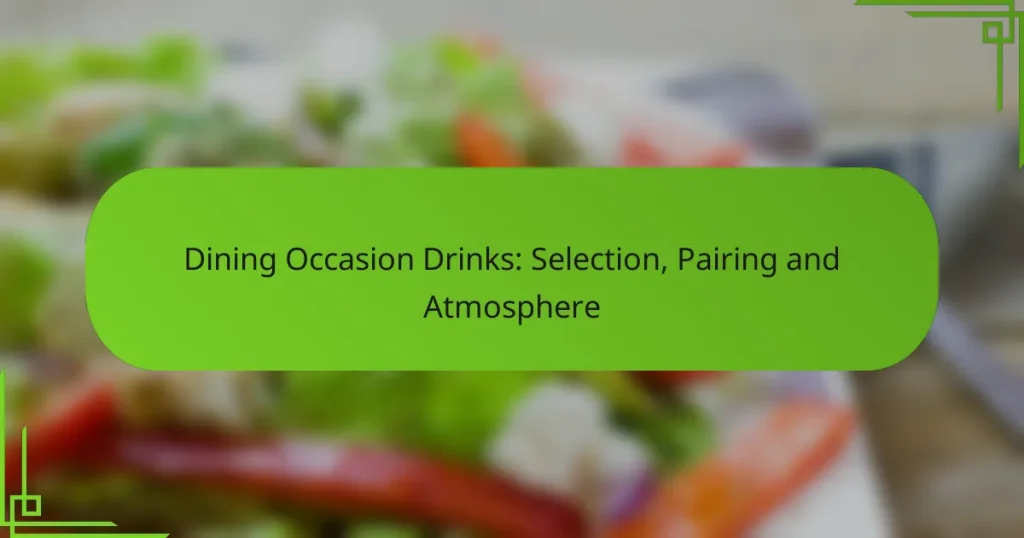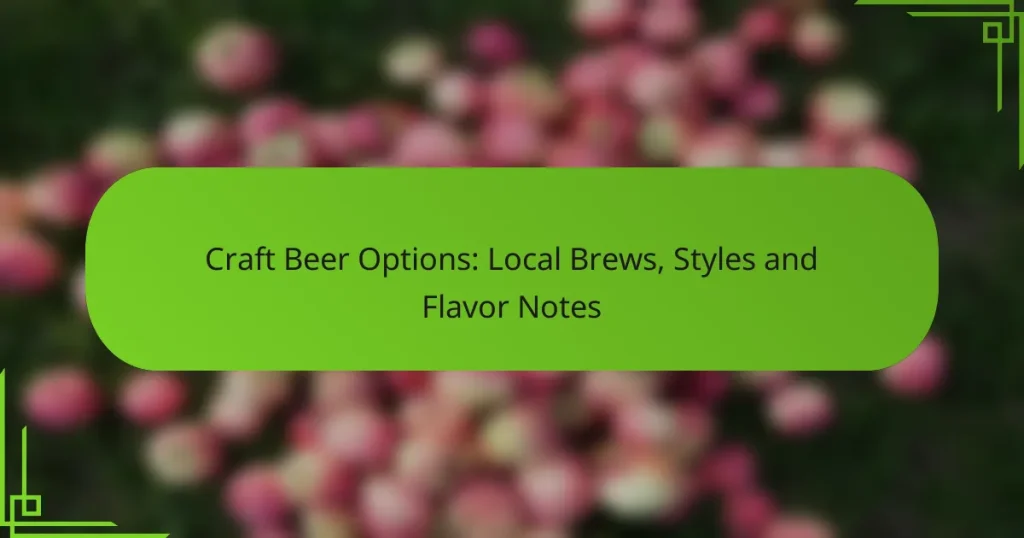At local bars and grilles, you’ll find a wide array of drink options designed to suit every palate. From refreshing cocktails and artisanal craft beers to fine wines and innovative non-alcoholic beverages, each choice offers a unique taste experience. Thoughtfully pairing your drink with your meal can elevate your dining experience, enhancing the flavors of both food and beverage.
Wine Pairings: Selection, Flavor Profiles and Meal Compatibility
Non-Alcoholic Drinks: Variety, Flavor and Availability
Craft Beer Options: Local Brews, Styles and Flavor Notes
Seasonal Cocktails: Local Ingredients, Freshness and Creativity
Signature Cocktails: Creativity, Presentation and Experience Enhancement
Local vs National Brands: Quality, Selection and Pricing
What drink options are available at local bars and grilles?
Local bars and grilles typically offer a diverse selection of drinks, catering to various tastes and preferences. Common options include cocktails, craft beers, wines, non-alcoholic beverages, and specialty drinks, each providing unique flavors and experiences.
Cocktails
Cocktails are a staple at bars and grilles, often featuring a mix of spirits, juices, and flavorings. Popular choices include classics like margaritas, mojitos, and martinis, which can be customized with different ingredients. When ordering, consider the bartender’s specialty or any seasonal offerings for a unique experience.
Many establishments also offer cocktail specials during happy hours, allowing patrons to enjoy premium drinks at reduced prices. It’s a good idea to ask about these promotions to maximize value.
Craft beers
Craft beers have gained popularity in recent years, with many bars and grilles showcasing local breweries. These beers often feature unique flavors and brewing techniques, making them a favorite among enthusiasts. Look for rotating taps that highlight seasonal or limited-edition brews.
When selecting craft beers, consider trying a flight, which allows you to sample several varieties. This is an excellent way to discover new favorites and support local breweries.
Wines
Wines are commonly available at bars and grilles, with selections ranging from house wines to premium bottles. Many establishments offer wines by the glass, making it easy to pair a drink with your meal. Red, white, and rosé options are typically available, catering to different palates.
When choosing a wine, consider asking the staff for recommendations based on your meal or personal taste preferences. They can often suggest pairings that enhance the dining experience.
Non-alcoholic beverages
Non-alcoholic beverages are essential for those who prefer not to drink alcohol. Options often include sodas, iced teas, lemonades, and mocktails, which mimic the flavors of traditional cocktails without the alcohol. Many bars and grilles are increasingly creative with their non-alcoholic offerings.
When ordering, don’t hesitate to ask for unique mocktail options or customizations to suit your taste. This can enhance your experience while enjoying a meal with friends or family.
Specialty drinks
Specialty drinks often highlight the bar’s unique offerings and creativity. These can include signature cocktails, seasonal beverages, or drinks made with local ingredients. Bars may also create themed drinks for special events or holidays, adding an extra layer of fun to the experience.
Be sure to ask the bartender about any specialty drinks available. Trying something new can lead to delightful surprises and memorable experiences during your visit.
How do I choose the best drink for my meal?
Choosing the best drink for your meal involves considering the flavors and textures of both the food and the beverage. A well-paired drink can enhance your dining experience, complementing or contrasting with the dish to elevate its taste.
Pairing cocktails with appetizers
Cocktails can be a delightful way to start your meal, especially when paired with appetizers. Opt for lighter, refreshing cocktails like mojitos or gin and tonics with seafood or vegetable starters, as their crispness complements these flavors well.
For heartier appetizers such as meatballs or sliders, consider richer cocktails like an Old Fashioned or a whiskey sour. These drinks can stand up to the bold flavors of the food, creating a balanced experience.
Matching wines with entrees
When selecting wine for your entree, focus on the main ingredient of the dish. For instance, white wines like Chardonnay or Sauvignon Blanc pair well with chicken or fish, while red wines such as Cabernet Sauvignon or Merlot complement beef or lamb dishes.
Additionally, consider the preparation method. Grilled meats often pair nicely with smoky reds, while creamy sauces call for a fuller-bodied white. A general rule is to match the weight of the wine with the weight of the food for optimal pairing.
Choosing beers for pub fare
Beer is a versatile choice for pub fare, with many styles that can enhance your meal. Light lagers or wheat beers work well with fried foods like calamari or fish and chips, as their crispness cuts through the richness.
For heartier dishes such as burgers or barbecue, opt for amber ales or stouts. These beers have the body and flavor to complement the robust tastes of grilled meats and savory sauces. Always consider the seasoning of the dish, as spiced foods may benefit from hoppy IPAs that can balance the heat.
What are the popular drink trends in bars and grilles?
Popular drink trends in bars and grilles focus on unique flavors, local ingredients, and health-conscious options. Seasonal cocktails, local craft beers, and organic wines are leading the way, appealing to diverse consumer preferences and enhancing the dining experience.
Seasonal cocktails
Seasonal cocktails are crafted using fresh, in-season ingredients, which not only enhance flavor but also reflect the time of year. For instance, summer drinks might feature refreshing fruits like watermelon or citrus, while winter cocktails often incorporate spices and warm flavors like cinnamon or nutmeg.
When creating seasonal cocktails, consider sourcing ingredients from local farms or markets to support the community and ensure freshness. A rotating menu can keep patrons engaged and encourage repeat visits, as they look forward to trying new offerings.
Local craft beers
Local craft beers have gained immense popularity, with many bars and grilles prioritizing regional breweries. This trend allows establishments to offer unique flavors that reflect local tastes and brewing styles, often resulting in a more personalized drinking experience.
When selecting local craft beers, consider offering a variety of styles, such as IPAs, stouts, and lagers, to cater to different preferences. Highlighting these options on the menu can attract beer enthusiasts and support local businesses, fostering a sense of community.
Organic wines
Organic wines are becoming increasingly sought after, as consumers become more health-conscious and environmentally aware. These wines are produced without synthetic pesticides or fertilizers, appealing to those who prioritize sustainability and natural products.
When curating an organic wine list, focus on quality and variety, including options from different regions and grape varieties. Educating staff about the benefits of organic wines can enhance customer experience and encourage patrons to explore this growing category.
What are the pricing ranges for drinks at local bars and grilles?
Drink prices at local bars and grilles typically range from a few dollars for basic options to higher amounts for premium selections. Happy hour specials can offer significant discounts, while standard drink prices generally reflect the type of establishment and location.
Happy hour specials
Happy hour specials are promotional periods where bars and grilles offer discounted drinks, usually during early evening hours. Discounts can range from 20% to 50% off regular prices, making it an attractive time for patrons to enjoy beverages at lower costs.
Common happy hour offerings include reduced prices on draft beers, house wines, and select cocktails. It’s advisable to check with local establishments for specific times and available deals, as these can vary widely.
Standard drink prices
Standard drink prices at bars and grilles generally fall within a range of $5 to $12 for cocktails, $3 to $8 for beers, and $5 to $10 for wines by the glass. The exact pricing often depends on the bar’s location, ambiance, and clientele.
Many bars also offer a selection of non-alcoholic beverages, typically priced between $2 and $5. Understanding the standard pricing can help you budget for a night out and choose where to go based on your preferences.
Premium drink options
Premium drink options, such as craft cocktails or high-end spirits, can cost significantly more, often ranging from $12 to $25 or more. These drinks usually feature top-shelf liquors, unique ingredients, or elaborate presentations.
When considering premium options, look for signature cocktails that showcase the bar’s creativity or specialty drinks that may not be available elsewhere. While these drinks can be a splurge, they often provide a unique experience worth the price.
What permits are required for serving alcohol?
To serve alcohol legally, establishments must obtain the appropriate permits, which vary by location. Typically, these permits ensure compliance with local laws regarding the sale and distribution of alcoholic beverages.
Local alcohol licensing
Local alcohol licensing is essential for any bar or grille intending to serve drinks. The process usually involves applying for a license from the local government or regulatory authority, which may require background checks and proof of responsible service training.
Licenses can differ significantly based on the type of alcohol served, such as beer, wine, or spirits. It’s crucial to understand the specific requirements in your area, as some jurisdictions may have additional stipulations for outdoor seating or special events.
Health and safety regulations
Health and safety regulations play a critical role in the operation of bars and grilles serving alcohol. Establishments must adhere to local health codes, which often include maintaining cleanliness, proper food handling, and ensuring safe serving practices.
Regular inspections by health officials may occur, and failing to meet these standards can result in fines or loss of the alcohol license. It’s advisable to stay updated on local regulations and provide staff training to ensure compliance with health and safety protocols.
How do bars and grilles ensure quality in their drink selection?
Bars and grilles maintain quality in their drink selection by establishing strong supplier relationships, adhering to industry standards, and regularly updating their offerings based on customer preferences. This ensures that they provide fresh, high-quality beverages that meet customer expectations.
Supplier partnerships
Building solid partnerships with suppliers is crucial for bars and grilles to ensure the quality of their drink selection. Reliable suppliers provide consistent access to high-quality ingredients, whether it’s craft beers, premium spirits, or fresh mixers. Establishing long-term relationships can also lead to better pricing and exclusive products.
When selecting suppliers, bars should consider factors such as product quality, delivery reliability, and the supplier’s reputation in the industry. Regularly reviewing supplier performance helps maintain standards and allows bars to pivot to new suppliers if necessary.
Additionally, bars can benefit from collaborating with local breweries or distilleries, which not only supports the local economy but also offers unique drink options that can attract customers. Highlighting these local partnerships in marketing can enhance the bar’s appeal and promote community engagement.






